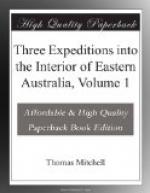January 30.
The cart returned with some fine timber which was soon placed on the saw-pit; meanwhile a stockyard for the cattle was erected on the higher ground.
NATIVES’ METHOD OF FISHING.
No fish could be caught this day, and we supposed that the natives were busy taking them above and below our camp for, in their mode of fishing, few can escape. We had previously seen the osier nettings erected by them across the various currents, and especially in the Gwydir, where some had been noticed of very neat workmanship. The frame of each trellis was as well squared as if it had been the work of a carpenter, and the twigs were inserted at regular intervals, so as to form, by crossing each other, a strong and efficient kind of net or snare. Where these were erected a small opening was left towards the middle of the current, probably that some bag or netting might be applied there to receive the fish while the natives in the river above should drive them towards it. The river continued still to fall during the day.
NATIVE DOG.
January 31.
The sky overcast. A good supply of fish caught in the morning. A small black native dog made its appearance about the camp, and was immediately run down and worried by our dogs. From the miserable mangey appearance of this animal I conjectured that it had belonged to the natives who were probably skulking about us, and who are very much attached to their dogs. I was therefore very sorry that this poor animal had been killed; and that no traces might remain of our apparent want of kindness I ordered the body to be burnt, and gave positive instructions to prevent strange dogs being worried in future. This day we completed the planking of the boat.




